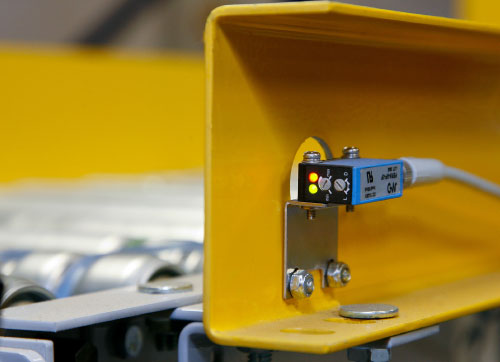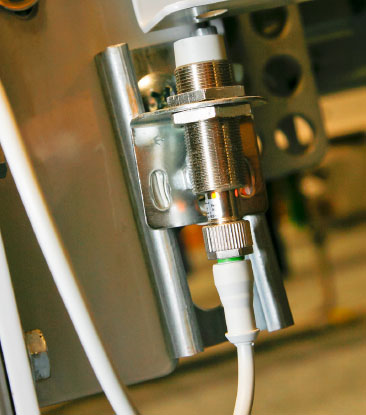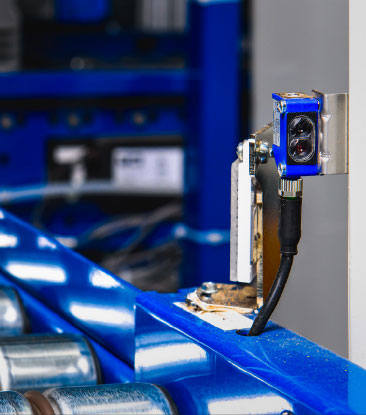- By Bill Sonnenthal
- August 30, 2023
- Features
Summary
Application characteristics help specifiers choose the best discrete sensor type.

There are many types of sensors on the market, using a variety of technologies. Sometimes these are called discrete sensors, but in general discrete object detection refers to any method of sensing a target. Some specific styles are called proximity (prox) sensors, but there are many other kinds such as photoelectric, electromechanical, and more. With so many choices, it can be tough for specifiers to ensure they are getting the best sensor for the job, as there are often multiple options that will work well.
Field-proven experience is considered as a top guide for sensor selection. However, there are many instances where a completely new application is being evaluated. And even when products have been used for a while because “we have always done it that way,” there is a good case for periodically reviewing available products to look for technology, performance, and price improvements.
Fortunately, it is possible to zero-in on the best industrial sensor candidates by considering a series of questions about the application. This requires knowledge about the target object, the operating environment, detection requirements, and connectivity to the host automation.
Target object
The most obvious first question regards what the target consists of, which usually takes the specifier down one of two paths:
- Products: liquids, powders, pellets, grain, etc.
- Objects: solids made of metal, plastic, cardboard, or other materials
Detecting products will typically require capacitive or ultrasonic technologies. Solid objects can be detected with a wide variety of prox technologies, or other methods such as photoeyes. Target material types and densities will have an influence on prox switch sensing effectiveness, and some vendors provide tables or other methods to assist with evaluation. When using optical technologies—such as photoeyes—the target size, distance, color, and other characteristics (lightness, darkness, clarity, or reflectiveness) will play a role.
Detection requirements
For product detection, it is necessary to define whether the sensor can be in contact with the material, or if it should sense at a distance. These two considerations are also important for object detection, with a few other modifiers. If the target is magnetic, there are specific prox sensors for that service. Also, if the sensing distance becomes relatively large, photoeye and laser sensors may work best.
Sensing distance is itself an important topic, with these considerations:
Contact. This type of presence sensing is very positive, and is usually accomplished with a mechanical limit switch, or sometimes a capacitive or inductive prox. However, contact sensing runs the risk of marring the sensed object. Also, mechanical switches have a finite actuation lifetime, and repeated contact with any kind of target can wear or degrade a sensor.
Non-contact close distance. Many types of capacitive and inductive proximity switches work well in a non-contact manner for distances of about 40mm or less, especially if the sensor and target can be mechanically configured to avoid contact. Also, it is often possible to affix a magnet to the target and use a magnetic prox to sense it.
Non-contact farther distance. For distances greater than 40mm, ultrasonic proxes are an option for large targets. However, many designers find that photoeye and laser sensors are the best options, especially when the geometry allows the sensing elements to be mounted on opposing sides of the target.
Operating environment
It is also important to assess the environmental conditions, both for sensing implications and electrical installation. The IEC ingress protection (IP) rating system is used to identify what degree of resistance the sensor will provide to dust and moisture. Ratings of IP65 are common and indicate the device is dust-tight and protected against low-pressure water jets. There are other intermediate ratings, and some sensors are rated IP69K, which means they can withstand high-pressure high-temperature cleaning, such as found in life sciences, food & beverage, industrial vehicle, and other applications.
Note that the IP rating relates to the housing of the sensor itself and the method of wiring connection. Some sensors are threaded to accept conduit for maintaining their environmental ratings, but it is becoming more common for sensors to use molded-in pigtail cables (flying leads) for wiring at a junction box, or housing bodies or cables with industry standard M8 or M12 quick-disconnect (QD) connectors. QD cables and connectors make it very easy to replace damaged sensors, and the cables and fittings are available in various lengths, with axial or 90-degree angle formats, and field-wireable versions for installation flexibility.
Form factor
The form factor involves the size and shape of a sensor, how much space is available to mount it, and the target size. Typical sensors can be barrel-shaped or rectangular. Barrel-shaped styles are easy to thread through a bracket to adjust the spacing. A non-flush style is a standard offering, but it must protrude through the bracket or fitting. Flush styles, as their name implies, can reside within a metal mounting. Larger sensors will have greater sensitivity, but smaller sensors are often needed for constrained spaces. It is usually best for the target to be at least as large as the sensor’s active surface.
Specialty requirements
General-purpose sensors work for many applications, but some specialty versions are more suitable for some applications:
- Weld slag resistant sensors prevent buildup of weld spatter and are more easily cleaned
- Weld field immune sensors are recommended in welding areas to resist the high level of electrical noise and magnetic fields
- High temperature sensors are resistant for temperatures up to 230DegC and are needed for some machine and foundry applications
- High pressure sensors are suitable for hydraulic applications
- Metal chip immunity sensors resist false signals due to the metal debris commonly generated in some machining applications
Evaluate electrical specs
Many years ago, limit switches would often be hardwired to interact with pushbuttons and lights, and even to interlock with larger electrical loads like solenoids, relays/contactors, and motors. It was common for these switches to use electromechanical contacts, operate at 120V AC, and carry high currents—but these types of physical contacts wear out and can fail in a welded-closed state.
Solid-state outputs use various electronic devices to switch current with no moving parts. They are smaller, faster, and quieter than mechanical contacts, and offer exceptionally long lifetimes, as long as they are not overloaded. Their high-frequency switching capability is essential for applications like gear-tooth sensing.
However, solid-state devices typically can’t switch as much current as their electromechanical counterparts. They also have some small leakage current even in the “off” state, which can be problematic when they are connected to some types of electronic automation devices, such as a programmable logic controller input module.
Electromechanical contacts versus solid-state outputs is only one type of electrical specification that needs to be evaluated. Other include:
24V DC PNP versus NPN. Although there is still a need for 120V AC 2-wire sensing devices, industry has largely moved to 24V DC 3-wire sensors. The lower voltage is safer, and to a great extent the sensors for modern automation are wired to digital controllers with very low current draws, so this level of power is adequate.
For 3-wire 24V DC sensors, one wire is +24V, another is 0V, and the third is the switched sensing signal. For DC sensors, designers must pay attention to whether they need a PNP/sourcing or NPN/sinking version, although some modern devices support both types of logic. PNP devices switch +24V to the load, while NPN types switch 0V to the load. PNP/sourcing is most intuitive for most users.
Normally-open (NO) versus normally-closed (NC). The terms NO and NC are a throwback to when there were only electromechanical contacts, but the concept still applies to all types of sensor selection.

Some sensors offer combined NO/NC functionality. The logic users are implementing, and how they want the system to fail safe upon power failure or cut wiring, will dictate the NO or NC format.
IO-Link digital bus. Traditional hardwired sensors are still widely used, but digital buses like IO-Link provide high-speed digital communications of many sensor parameters and device power, all via a single cable. Specifiers can realize many performance and overall cost savings advantages by incorporating IO-Link sensors (Figure 1).
A quick survey of sensor styles
Following are summaries of some of the most common discrete sensing devices, and where each offers the best price/performance ratio.
Limit switches use a mechanism such as a lever, plunger, or other arrangement in a variety of form factors to operate physical electromechanical contacts. These are a simple and economical option for many types of equipment and material handling situations.

Inductive proximity generate an electromagnetic field used for detecting various metallic objects at relatively close range. Ferrous metals are easiest to detect, but other metals work also, and some technologies like “Factor 1” offer the same sensing range for any metal target. Especially good for sensing the position of equipment travelling on known paths (Figure 2).
Capacitive proximity generate an electrostatic field used for detecting all types of objects and materials at relatively close range. They can sense target products through insulating materials, such as a plastic window in the side of a bin or vessel.

Photoelectric sensors use light—visible red, infrared, or laser wavelengths—to detect targets over relatively large distances (Figure 3). The emitter/sender and the receiver can be in one housing (diffuse), or in two housings (through-beam), in either case arranged to detect objects crossing their path. Some diffuse sensors detect objects directly, while retroreflective version detect the object obscuring a reflector located away from the sensor but across the object’s path. These sensors are especially useful for detecting conveyed goods like boxes. Similar to NO/NC, a photoelectric sensor may be configurable to provide an output when light is blocked from entering the sensor (dark-on), or when light does enter the sensor (light-on).
Getting the right discrete sensor
Selecting the right discrete sensor for any given application requires specifiers to consider a number of factors, and perhaps even make some tradeoffs. There is no single best technology, and sometimes there are multiple types of sensors that may serve well in a given application.
However, by evaluating the requirements associated with the target type, form factors, environment, and other details described in this article, designers will be able to obtain the right sensing product for their industrial automation application.
All figures courtesy of AutomationDirect.
Reader Feedback
We want to hear from you! Please send us your comments and questions about this topic to InTechmagazine@isa.org.


